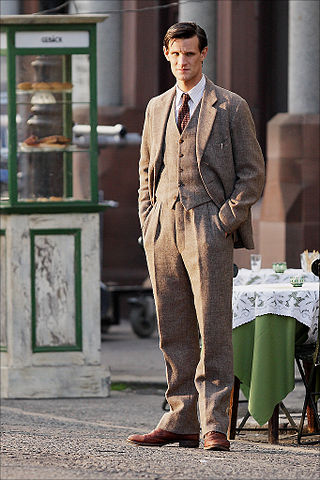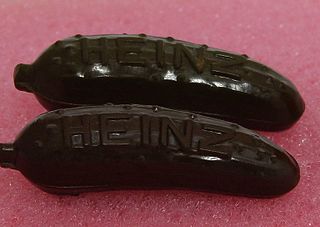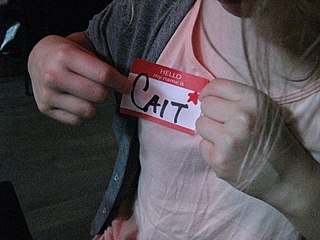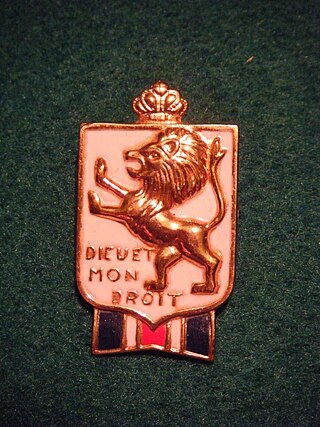
A button is a fastener that joins two pieces of fabric together by slipping through a loop or by sliding through a buttonhole.

A suit, lounge suit, or business suit is a set of clothes comprising a suit jacket and trousers of identical textiles generally worn with a collared dress shirt, necktie, and dress shoes. A skirt suit is similar, but with a matching skirt instead of trousers. It is currently considered semi-formal wear or business wear in contemporary Western dress codes, however when the suit was originally developed it was considered an informal or more casual option compared to the prevailing clothing standards of aristocrats and businessmen. The lounge suit originated in 19th-century Britain as sportswear and British country clothing, which is why it was seen as more casual than citywear at that time, with the roots of the suit coming from early modern Western Europe formal court or military clothes. After replacing the black frock coat in the early 20th century as regular daywear, a sober one-coloured suit became known as a lounge suit.

A badge is a device or accessory, often containing the insignia of an organization, which is presented or displayed to indicate some feat of service, a special accomplishment, a symbol of authority granted by taking an oath, a sign of legitimate employment or student status, or as a simple means of identification. They are also used in advertising, publicity, and for branding purposes.
Button Men is a two-player dice game invented by James Ernest of Cheapass Games, first released in 1999.

Cufflinks are items of jewelry that are used to secure the cuffs of dress shirts. Cufflinks can be manufactured from a variety of different materials, such as glass, stone, leather, metal, precious metal or combinations of these. Securing of the cufflinks is usually achieved via toggles or reverses based on the design of the front section, which can be folded into position. There are also variants with chains or a rigid, bent rear section. The front sections of the cufflinks can be decorated with gemstones, inlays, inset material or enamel and designed in two or three-dimensional forms.

The Heinz pickle pin is an advertising item from the H. J. Heinz Company, being a small green pin made in the shape of a pickle. Being continuously offered for more than a century, and with more than 100 million pins produced over the years, it is both one of the longest-running and most successful promotions in history.

A dress shirt, button shirt, button-front, button-front shirt, or button-up shirt is a garment with a collar and a full-length opening at the front, which is fastened using buttons or shirt studs. A button-down or button-down shirt is a dress shirt with a button-down collar – a collar having the ends fastened to the shirt with buttons.

In clothing, a collar is the part of a shirt, dress, coat or blouse that fastens around or frames the neck. Among clothing construction professionals, a collar is differentiated from other necklines such as revers and lapels, by being made from a separate piece of fabric, rather than a folded or cut part of the same piece of fabric used for the main body of the garment.

A double-breasted garment is a coat, jacket, waistcoat, or dress with wide, overlapping front flaps which has on its front two symmetrical columns of buttons; by contrast, a single-breasted item has a narrow overlap and only one column of buttons.

A lapel is a folded flap of cloth on the front of a jacket or coat below the collar. It is most commonly found on formal clothing and suit jackets. Usually it is formed by folding over the front edge of the jacket or coat and sewing it to the collar, an extra piece of fabric around the back of the neck.

Battledress (BD), later named the No. 5 Uniform, was the combat uniform worn by British Commonwealth and Imperial forces through the Second World War.

A lapel pin, also known as an enamel pin, is a small pin worn on clothing, often on the lapel of a jacket, attached to a bag, or displayed on a piece of fabric. Lapel pins can be ornamental or can indicate the wearer's affiliation with a cause or an organization, such as a fraternal order or religious order; in the case of a chivalric order, the lapel pin is in the form of a rosette. Before the popularity of wearing lapel pins, boutonnières were worn.

A name tag is a badge or sticker worn on the outermost clothing as a means of displaying the wearer's name for others to view.

A jugate consists of two portraits side by side to suggest, to the viewer, the closeness of each to the other. The word comes from the Latin, jugatus, meaning joined or overlapping.

Button collecting is the collecting of various types of clothing buttons.
Prizes are promotional items—small toys, games, trading cards, collectables, and other small items of nominal value—found in packages of brand-name retail products that are included in the price of the product with the intent to boost sales, similar to toys in kid's meals. Collectable prizes produced in series are used extensively—as a loyalty marketing program—in food, drink, and other retail products to increase sales through repeat purchases from collectors. Prizes have been distributed through bread, candy, cereal, cheese, chips, crackers, laundry detergent, margarine, popcorn, and soft drinks. The types of prizes have included comics, fortunes, jokes, key rings, magic tricks, models, pin-back buttons, plastic mini-spoons, puzzles, riddles, stickers, temporary tattoos, tazos, trade cards, trading cards, and small toys. Prizes are sometimes referred to as "in-pack" premiums, although historically the word "premium" has been used to denote an item that is not packaged with the product and requires a proof of purchase and/or a small additional payment to cover shipping and/or handling charges.

A pin-back button or pinback button, pin button, button badge, or simply pin-back or badge, is a button or badge that can be temporarily fastened to the surface of a garment using a safety pin, or a pin formed from wire, a clutch or other mechanism. This fastening mechanism is anchored to the back side of a button-shaped metal disk, either flat or concave, which leaves an area on the front of the button to carry an image or printed message. The word is commonly associated with a campaign button used during a political campaign. The first design for a pin-back button in the United States was patented in 1896, and contemporary buttons have many of the same design features.

The British War Relief Society (BWRS) was a US-based humanitarian umbrella organisation dealing with the supply of non-military aid such as food, clothes, medical supplies and financial aid to people in Great Britain during the early years of the Second World War. The organisation acted as the administrative hub and central receiving depot for items donated from other charities which were then parceled out to its affiliate organizations in the US and to Britain. These donations were raised in the name of the BWRS, rather than in the name of the smaller groups.
The American Political Items Collectors is a 501(c)3 non profit organization founded in 1945 to encourage the study, collecting, and preservation of political campaign memorabilia. It is the largest organization of political memorabilia collectors in the United States. The group actively seeks to educate the general public about government and political history through displays at libraries and museums, as well as educating the public about reproduction items.





















